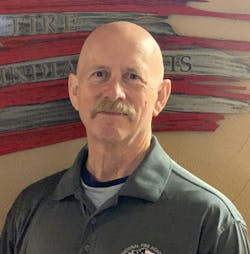Many firefighters enjoy fighting fires only slightly more than that second great joy of theirs: complaining. Over the years that I spent going from firefighter to deputy chief, I learned that there’s a great difference between complaining and knowing how to complain. With all due respect to Sun Tzu, I call it the art of WAR, or we articulate responses. You can help your administration or boss help you get what you want by providing them with what they need—i.e., an articulated response. You both should be in this together.
An articulated response
It’s very easy to trigger emotions in a discussion about any topic that’s perceived as relevant to the moment. However, an emotional response is less than useless and actually can ruin the chances of a resolution. Instead, the response must be articulated, which requires rational thought and data.
Let’s say that firefighters at a station complained for years about how hot it was in the apparatus bay during several months of the year. The facility was the hazmat station and, as such, housed a lot of specialized equipment. Complaining was going nowhere. It was suggested that firefighters record the bay temperatures, with accompanying documentation, such as time of day, duration of excessive temperature and dates. Next, they determined what defined “excessive temperature.” They looked at manufacturers’ information to find acceptable temperatures for the storage of equipment. They found that most of the various manufacturers listed 95 degrees Fahrenheit as the maximum storage temperature.
With that number and the accumulated data, a very articulated response was formed: “We need an investment of $30,000 to provide 95,000 Btu of cooling in the apparatus bay to provide protection, per manufacturers’ requirements, to our $750,000 worth of equipment. Our equipment is at risk of degradation because of the bay temperatures being an average of 18 degrees F above maximum for an average of 10 hours per day, from July 20, 2025, to Sept. 4, 2025.”
Department administration now is empowered to also make an articulated response on the firefighters’ behalf: “Your Honorable Mayor, I suggest we approve the expenditure or face the loss of a specific service—hazmat—that only we can provide. Without this money being approved, we are faced with marking equipment out of service, effectively ending a service that had 120 calls for it the past year. Additionally, we would have to rapidly recalculate the purchasing cycle, which would increase costs by an estimated
30 percent if we can’t get the bay temperature below the maximum that’s set by the manufacturers. Furthermore, this equipment is life-safety per Occupational Safety and Health Administration’s 1910.120 standard and the NFPA 470: Hazardous Materials/Weapons of Mass Destruction (WMD) Standard for Responders. As occupational life-safety equipment, it’s subject to rigorous daily inspection that we perform. Let’s see what guidance NFPA and OSHA can give the city. Let’s give our friends down at OSHA a call to invite them here for an opinion, shall we?”
That certainly makes for a more compelling and powerful request to get what the firefighters wanted than simply complaining that it’s hotter than the hinges of hell in the apparatus bay. I remember the days when fire chiefs were trusted simply based on their word. Those days, right or wrong, are gone. A lot of chiefs answer to professional city managers and politicians who lack understanding about the fire service. Costs, from a management perspective, are a concept and argument that they clearly understand. They very likely understand industry-accepted best practice and OSHA.
Debated widely at many a firehouse kitchen table throughout the country is the fact that, although NFPA 470 is a voluntary consensus standard, it represents an industry-accepted best practice and certainly is the standard to which departments can be measured under OSHA’s General Duty Clause. The General Duty Clause requires employers to protect employees from recognized hazards. If nothing else, NFPA 470 serves as an identifier of industry-accepted best practices concerning recognized hazards. This is why NFPA 470 was cited so heavily in the proposed upgrade to OSHA’s Fire Brigade Standard, which caused such a furor. This isn’t to suggest that this is how it’s handled in every area of the country. Logical, passionate arguments have been made both ways, but I believe the jury is still out.
At the end of the day, if you don’t know how NFPA and OSHA interplay in your area, you better find out.
Objective, quantifiable data
Another for instance to illustrate how complaining is different from knowing how to complain: Consider this articulated response concerning exhaust pollution in the bay.
Instead of using the complaints that so many have used—“Hey, Chief, it sucks that we don’t have exhaust hoses” or “You guys must do something about this”—consider, “Hey, Chief, the way that we currently are doing our morning checks isn’t safe. Without exhaust hoses, we are filling the bay with hazardous materials. We must either breathe it, put on SCBA or open every door in the apparatus bay, even when it’s -20 degrees F, and stick a fan in the door. National Institute for Occupational Safety and Health limits carbon monoxide exposure to 50 ppm. The limit for nitrous oxides, another component of diesel exhaust, is one-tenth of that: 5 ppm. Diesel exhaust particulate matter itself is limited to only 160 micrograms per cubic meter. If we were sent on a reported leak that involves these materials, we would be in Level A hazmat suits. I suggest that we get OSHA down here to do some measuring themselves to see where we stand.”
Once again, this example employs objective, quantifiable data and information that can be debated on their own merits.
Increasing the odds
No, this art of WAR doesn’t guarantee that you will get results, but it certainly dramatically increases the odds. Even if denied, you have a clear data set and record that you can build from. Eventually, whoever holds the purse strings will face the following dilemma: Either fund the request based on the science and case presented, spend money investigating the science in the request to at least an equal or better level to dispute it, or roll the dice and hope that they’re out of office before an incident and the data intersect.
About the Author

Jim Campbell
Jim Campbell began his fire service career as a volunteer firefighter for the Greenwood, IN, Fire Department in 1983 and was hired as a career firefighter by the Pike Township Fire Department (Indianapolis) in 1985. He rose through the ranks to deputy chief of operations. Campbell holds an associate degree in fire science from the University of Cincinnati. He is certified as an Executive Fire Officer and is a principal member of the committees for NFPA 1010: Standard for Professional Qualifications for Firefighters, NFPA 1020: Standard for Fire and Emergency Services Instructor, Fire Officer, and Emergency Medical Services Officer Professional Qualifications, NFPA 1400: Standard on Fire Service Training and NFPA 470: Hazardous Materials/Weapons of Mass Destruction (WMD) Standard for Responders. Campbell now serves as a captain on a private fire brigade.
